Choosing the Right SSD for a Skylake-U System
by Ganesh T S on May 9, 2016 8:00 AM ESTSYSmark 2014 Benchmarks
BAPCo's SYSmark 2014 is an objective performance benchmark for PCs. It is based on running real computer applications that one might use in day-to-day business / office activities. It is important to note that it does not intend to artificially drive components to peak capacity. Real user workloads and datasets are processed to determine how the user experience is impacted by the performance of the system.
SYSmark 2014 has three usage scenarios
- Office Productivity
- Media Creation
- Data/Financial Analysis.
The Office Productivity scenario models productivity usage including word processing, spreadsheet data manipulation, email creation/management and web browsing. The Media Creation scenario models using digital photos and digital video to create, preview, and render advertisements for a fictional businesses. The Data/Financial Analysis scenario creates, compresses, and decompresses data to review, evaluate and forecast business expenses. Also, the performance and viability of financial investments is analyzed using past and projected performance data.
The raw scores are meant to be compared against the 1000 scored by a Haswell Core i3-based desktop sporting a 500GB hard drive and 4GB of RAM. A score of 2000 would meant that the PC under test would appear to be twice as responsive as the calibration system.
SYSmark 2014's whitepaper (PDF) includes sensitivity analysis - how the scores vary with the amount of RAM, processor choice, GPU, storage drive, OS and display resolution. The whitepaper's sensitivity analysis for the storage subsystem involves comparison of a hard-drive based system and a SATA SSD. One can get as much as 20% improvement in scores (depending on the workload) by upgrading from a HDD to a SSD.
Since our evaluation also keeps all the system hardware and software the same, except for the storage drive, it also fits SYSmark 2014's sensitivity analysis model. What is the improvement when one goes from a SATA SSD to a PCIe SSD, or, from a PCIe AHCI SSD to a PCIe NVMe SSD, or, from a PCIe 2.0 x4 SSD to a PCIe 3.0 x4 SSD? The graphs in this section bring out the SYSmark 2014 scores in these scenarios.
A note about the colors used in the graphs is in order. Since we are dealing with a number of degrees of freedom - BIOS version differences corresponding to OPI GT2 and OPI GT4 rates, as well the characteristics of the SSDs themselves - PCIe vs. SATA and AHCI vs. NVMe, we chose to go with a lighter color shade for the older BIOS / OPI GT2 link and separate colors for the different SSDs.
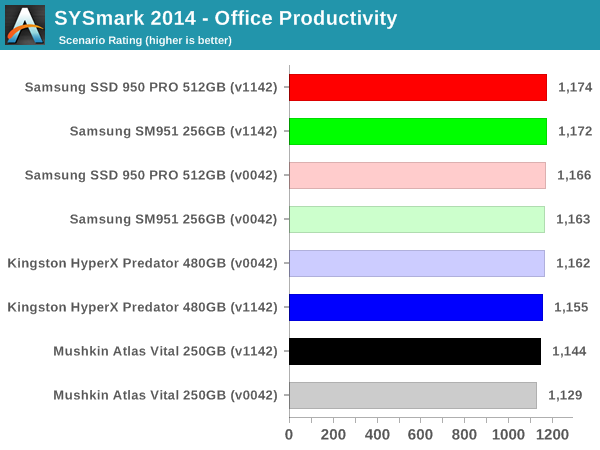
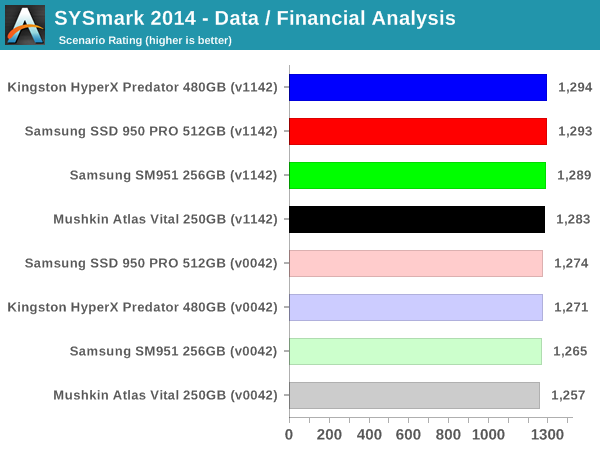
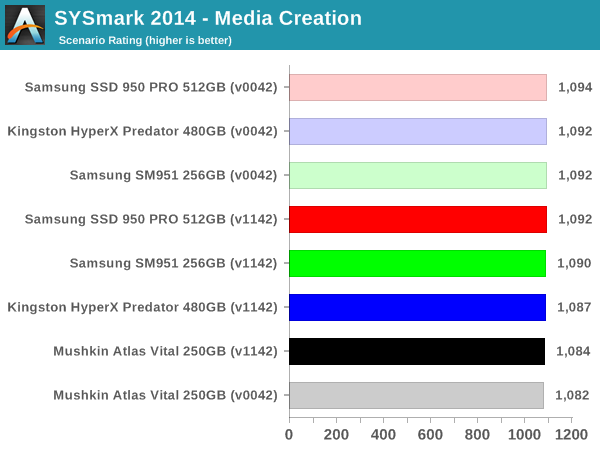
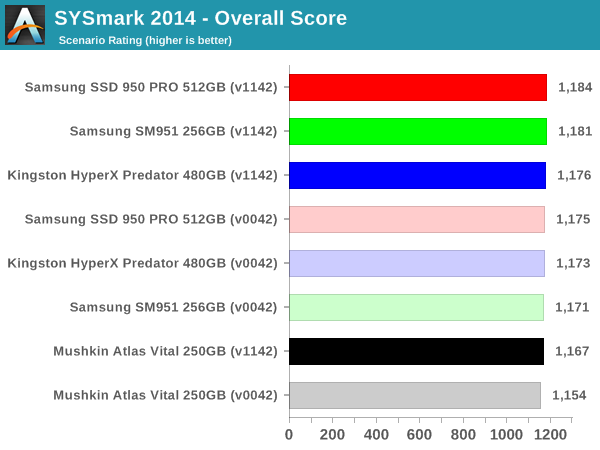
The important takeaway here is that day-to-day PC activities have little to gain by moving from AHCI to NVMe or from PCIe 2.0 x4 to PCIe 3.0 x4. There is a bit of discernible benefit in moving from SATA to PCIe, though. Surprisingly, the OPI GT4 rates improve the scores quite a bit for the Mushkin Atlas Vital SATA SSD. This means that even budget Skylake NUC users using traditional SATA SSDs have something to gain by moving to the BIOS with OPI GT4 rates when it becomes public.


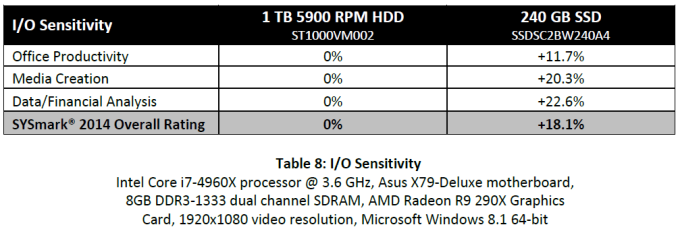








40 Comments
View All Comments
BPB - Monday, May 9, 2016 - link
"We also managed to check out four different SSDs for usage in Skylake-U systems in general (and the NUC6i5SYK in particular)."The new NUCs are not capable of using the 950 Pro at full speed. Yes, the specs look like they do, but they don't. The maximum speed supported is 1600MB/s. Page 45 of this doc has the specs:
http://www.intel.com/content/dam/support/us/en/doc...
You can also view a discussion at the Intel Community regarding this:
https://communities.intel.com/message/372201#37220...
This being the case, which SSD makes the best buy?
ganeshts - Monday, May 9, 2016 - link
Please go through the article at least once before commenting. Did you look at the CrystalDiskMark benchmark numbers with the NEW DEVELOPMENT BIOS? Intel has resolved this issue, and the whole point of this review was going into the reasons behind this.BPB - Monday, May 9, 2016 - link
Sorry, read while at work and only had time to breeze through. I looked for those numbers but didn't see them. Wish I could delete my post...willis936 - Monday, May 9, 2016 - link
Does this apply to all -U processors? I think far more interesting than NUCs are people with broadwell and skylake -U laptops.ganeshts - Monday, May 9, 2016 - link
This is applicable to all Skylake-U processors.Yes, notebooks are an interesting category that we have tried to cover in this article, but, without numbers to back up. Our impression is that the lower idle power needed for notebooks might make vendors go with the GT2 OPI setting. So, the numbers are likely to be closer to the BIOS v0042 results that we saw in this review. So, yes, it is likely that PCIe 3.0 x4 SSDs can't get full performance with Skylake-U laptops. Of course, vendors have the knob to turn on the higher performance / higher idle power setting, if they want.
rish95 - Tuesday, May 10, 2016 - link
You guys wouldn't happen to have power consumption numbers on the PM951, would you?It appears the Surface Book's drive is replaceable following a tedious opening procedure, and I've been thinking of replacing the 128 GB PM951 that came with mine with a larger 950 Pro or its successor. The 128 PM drive has terrible slow write performance due to the lack of TurboWrite.
However, I am concerned that the extra performance the 950 and SM series SSDs offer comes at a huge power penalty, and I certainly wouldn't want to give up the fantastic battery life this device offers.
ez76 - Monday, May 9, 2016 - link
How can I tell if my Skylake-U system has an OPT GT2 or OPT GT4 configuration?ganeshts - Monday, May 9, 2016 - link
Easiest way is to ask the manufacturer. Otherwise, if the system has a M.2 PCIe x4 slot for a SSD, benchmark something like the SSD 950 PRO using CrystalDiskMark.Hopefully, after Intel makes this BIOS public, more vendors will put out BIOS updates and spell the OPI link rate out in the change log.
Junkmail1 - Monday, May 9, 2016 - link
I went through the article twice and the comments once. Now I'm second guessing that choice!buyme50 - Saturday, May 14, 2016 - link
"However, the warranty aspect is a bit worrisome, since the SM951 is an OEM model."Thank you for mentioning this. I had an SM951 die recently. Newegg's third party seller would not honor the warranty posted (3 years), Newegg would not do anything, and Samsung refused to warranty it. Don't buy the SM951 unless you don't want a warranty and want to risk losing your data.